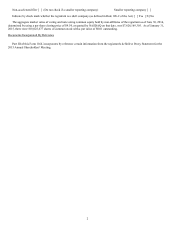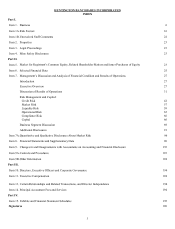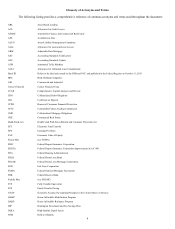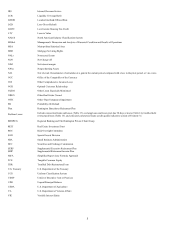Huntington National Bank 2014 Annual Report Download - page 16
Download and view the complete annual report
Please find page 16 of the 2014 Huntington National Bank annual report below. You can navigate through the pages in the report by either clicking on the pages listed below, or by using the keyword search tool below to find specific information within the annual report.10
The Federal Reserve maintains a bank holding company rating system that emphasizes risk management, introduces a framework
for analyzing and rating financial factors, and provides a framework for assessing and rating the potential impact of non-depository
entities of a holding company on its subsidiary depository institution(s). The ratings assigned to us, like those assigned to other
financial institutions, are confidential and may not be disclosed, except to the extent required by law.
The Federal Reserve utilizes an updated framework for the consolidated supervision of large financial institutions, including bank
holding companies with consolidated assets of $50 billion or more. The objectives of the framework are to enhance the resilience of a
firm, lower the probability of its failure, and reduce the impact on the financial system in the event of an institution’s failure. With
regard to resiliency, each firm is expected to ensure that the consolidated organization and its core business lines can survive under a
broad range of internal or external stresses. This requires financial resilience by maintaining sufficient capital and liquidity, and
operational resilience by maintaining effective corporate governance, risk management, and recovery planning. With respect to
lowering the probability of failure, each firm is expected to ensure the sustainability of its critical operations and banking offices under
a broad range of internal or external stresses. This requires, among other things, that we have robust, forward-looking capital-
planning processes that account for our unique risks.
The Bank, which is chartered by the OCC, is a national bank and our only bank subsidiary. It is subject to examination and
supervision by the OCC and also by the CFPB, which was established by the Dodd-Frank Act in 2010. Our nonbank subsidiaries are
also subject to examination and supervision by the Federal Reserve or, in the case of nonbank subsidiaries of the Bank, by the OCC.
All subsidiaries are subject to examination and supervision by the CFPB to the extent they offer any consumer financial products or
services. Our subsidiaries are subject to examination by other federal and state agencies, including, in the case of certain securities
and investment management activities, regulation by the SEC and the Financial Industry Regulatory Authority.
In September 2014, the OCC published final guidelines to strengthen the governance and risk management practices of large financial
institutions, including the Bank. The guidelines became effective November 10, 2014, and require covered banks to establish and
adhere to a written governance framework in order to manage and control their risk-taking activities. In addition, the guidelines
provide standards for the institutions’ boards of directors to oversee the risk governance framework. Given its size and the phased
implementation schedule, the Bank is subject to these heightened standards effective May 2016. As discussed in Item 1A: Risk
Factors, the Bank currently has a written governance framework and associated controls.
Legislative and regulatory reforms continue to have significant impacts throughout the financial services industry.
The Dodd-Frank Act, enacted in 2010, is complex and broad in scope and several of its provisions are still being implemented.
The Dodd-Frank Act established the CFPB, which has extensive regulatory and enforcement powers over consumer financial products
and services, and the Financial Stability Oversight Council, which has oversight authority for monitoring and regulating systemic risk.
In addition, the Dodd-Frank Act altered the authority and duties of the federal banking and securities regulatory agencies,
implemented certain corporate governance requirements for all public companies including financial institutions with regard to
executive compensation, proxy access by shareholders, and certain whistleblower provisions, and restricted certain proprietary
trading, and hedge fund and private equity activities of banks and their affiliates. The Dodd-Frank Act also required the issuance of
numerous implementing regulations, many of which have not yet been issued. The regulations will continue to take effect over
several more years, continuing to make it difficult to anticipate the overall impact to us, our customers, or the financial industry in
general.
In January 2014, seven final regulations issued by the CFPB, including the ability to repay and qualified mortgage standards,
various mortgage servicing rules, a rule expanding the scope of the high-cost mortgage provision in the Truth in Lending Act, loan
originator compensation requirements and appraisal rules, became effective and were successfully implemented by Huntington. On
November 20, 2013, the CFPB issued its final rule on integrated mortgage disclosures under the Truth in Lending Act and the Real
Estate Settlement Procedures Act, for which compliance is required by August 1, 2015. The CFPB finalized amendments to the
integrated mortgage disclosures on January 20, 2015, which are also effective on August 1, 2015. On October 22, 2014, the CFPB
finalized minor Amendments to the 2013 Mortgage Rules under the Truth in Lending Act (Regulation Z), making certain nonprofits
exempt from some servicing rules and the ability to repay rule, and allowing a cure period for points and fees in Qualified
Mortgages. These changes were effective as of November 3, 2014. In addition, the CFPB proposed changes to its servicing rules.
We continue to monitor, evaluate and implement these new regulations.
Throughout 2014, the CFPB has continued its focus on fair lending practices of indirect automobile lenders. This focus has led to
some lenders acknowledging that the CFPB and Department of Justice are considering taking public enforcement actions against them
for their fair lending practices. Indirect automobile lenders have also received continuing pressure from the CFPB to limit or eliminate
discretionary pricing by dealers. Finally, the CFPB has proposed its larger participant rule for indirect automobile lending which will
bring larger non-bank indirect automobile lenders under CFPB supervision.
























